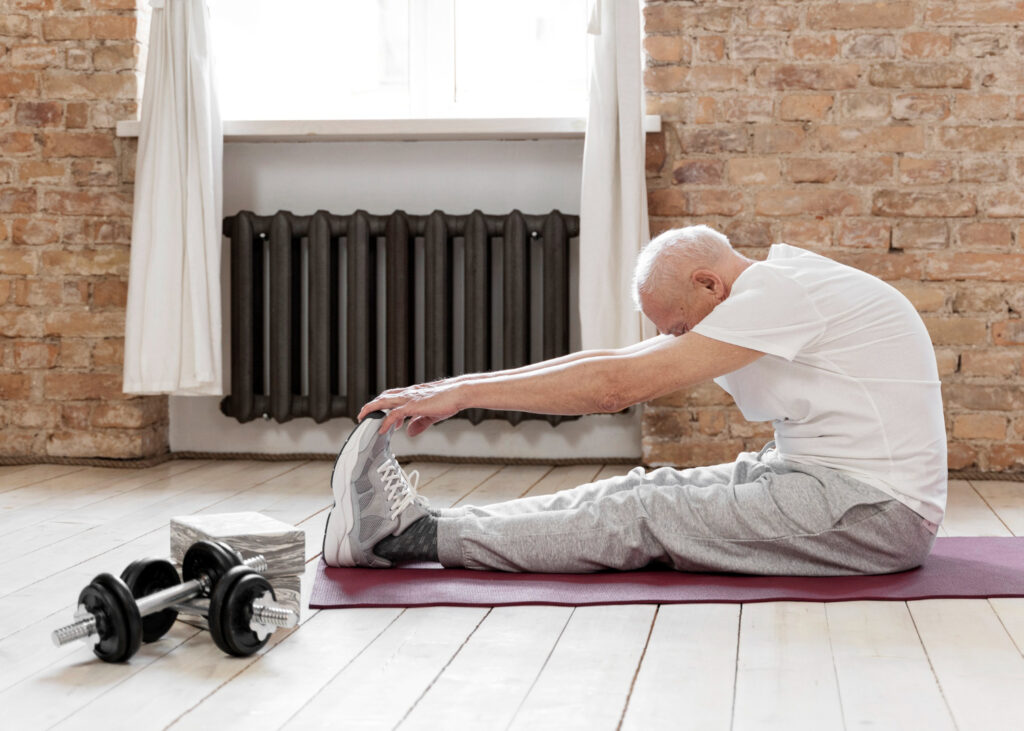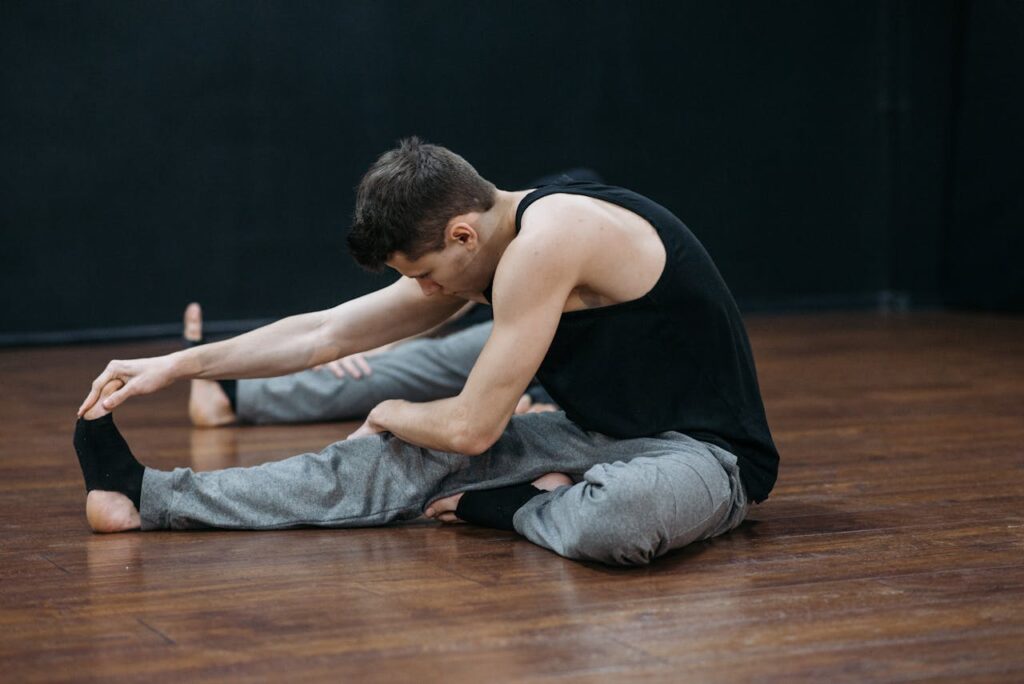Let’s be real. Most people don’t stretch enough. I see it all the time in the gym: finish a workout, wipe the sweat, maybe do a quick quad pull if they remember, and then they’re gone. Hamstring stretch? Completely ignored.
But here’s the truth: skipping a proper hamstring stretch is one of the fastest ways to stay stiff, mess up your posture, and even set yourself up for injuries. These muscles are way more involved than people give them credit for.
Think about it, your hamstrings are behind almost every move you make with your legs. Walking, running, climbing stairs, even sitting down on the couch, they’re always working. If they’re tight, you’ll feel it in more places than just your legs. Back pain, limited range of motion, and even awkward posture all trace back to these muscles being locked up.
I constantly advise my clients to avoid considering stretching as an optional extra because of this. Consider it a component of your training. What if you can only stretch one place in your time? Make it your hamstrings.
Why the Hamstring Stretch Is a Game Changer
Flexibility That Actually Matters
I’m not talking about circus-level flexibility. I mean, being able to move without feeling like your body is fighting against you. If you’ve ever bent over to grab something and felt that pulling, almost burning sensation in the back of your thighs? That’s your hamstrings screaming for attention. A simple hamstring stretch routine can free them up so that everyday movements stop feeling like a workout.
Say Goodbye to Nagging Injuries
Hamstring strains are brutal. I’ve had athletes sidelined for weeks just because of one bad step during a sprint. And here’s the kicker, it’s not only athletes who deal with it. When they play a recreational game of soccer or get out of the car too rapidly, even ordinary individuals might cause hamstring strains. Stretching the hamstrings frequently keeps the muscles flexible and lowers the chance of an unplanned break.
Back Pain Relief (That Surprises People)
This is one I see over and over. A client comes in complaining about lower back pain. They think it’s their spine, maybe even their mattress. But after testing their flexibility? Their hamstrings are so tight they’re pulling on their pelvis, throwing their whole alignment off. Once we build a habit of seated hamstring stretches and lying hamstring stretches, the back pain often eases up without fancy treatments.
Posture You Don’t Have to Force
Slouching, rounded shoulders, constant stiffness, yes, some of it is upper body, but tight hamstrings make it worse. They tilt your pelvis and mess with your spinal alignment. Stretching them regularly takes the pressure off your lower back, so standing tall feels natural instead of forced.
The Hamstring Stretch Exercises I Recommend Most
A yoga studio or costly equipment is not necessary. I utilize these stretches with all of my clients, from novices to elite athletes, and they can be performed anywhere.
Standing Hamstring Stretch
- Stand tall, feet hip-width.
- Slowly hinge forward from your hips rather than your lower back.
- Reach toward your toes (don’t stress if you can’t touch them yet).
- Hold for 20–30 seconds.
- Tip: Keep a micro-bend in your knees so you’re stretching muscles, not straining joints.
Seated Hamstring Stretch
- With one leg out in front of you, take a seat.
- Bend the other leg so the sole of your foot rests against your inner thigh.
- Reach toward the toes of your extended leg, keeping your chest lifted.
- Hold 20–30 seconds per side.
This seated hamstring stretch is one I recommend for almost everyone. It’s safe, controlled, and easy to adjust for your flexibility level.
Lying Hamstring Stretch
- With one leg out on the floor, lie on your back.
- The opposite leg should be raised straight up toward the ceiling.
- Gently draw it closer with your hands, a strap, or even a cloth.
- Hold for 20–30 seconds per leg.
This lying hamstring stretch is a go-to for anyone dealing with back pain because it keeps your spine supported.
Stretching the Hamstrings Dynamically Before Exercise
- Place your heel on the floor and one leg forward.
- Flex your toes up.
- Hinge slightly forward, then return to standing.
- Switch sides for 8–10 reps each.
I use this with athletes before sprinting or lifting. Preparing the hamstrings for movement is more important than holding.

How to Get the Most Out of Hamstring Stretching
A lot of people “stretch” without really getting the benefits. Here’s what I coach clients to keep in mind:
- Warm Up First: Don’t just dive into a hamstring stretch cold. A quick warm-up like walking or some light cardio will boost your energy and get your muscles ready, reducing the risk of pulling something.
- Stretching once a week won’t accomplish anything, so be regular. Aim for 3–4 sessions per week.
- Don’t push into pain – Stretching is about release, not forcing your body.
- Hold long enough – Fifteen seconds is fine, but 30 seconds is better.
- Breathe – Exhaling helps your muscles relax and lets you go deeper.
Mistakes I See All the Time
Even with something as simple as stretching, people mess it up. Here are the biggest ones:
- Locking the knees like they’re trying to prove something.
- Rather than hinging from the hips, rounding the back.
- Rushing through the stretch without letting the muscles actually release.
- Stretching one leg more than the other (hello, imbalances).
- Skipping stretching altogether because it “takes too much time.”
Stretching takes less time than recovering from a pulled hamstring, I promise.
An Easy Hamstring Stretch Routine That Has Been Approved by Trainers
If you’re prepared to begin, I suggest this easy routine for beginners:
- Warm up with eight to ten repetitions on each side for the Dynamic Hamstring Stretch.
- Standing Hamstring Stretch – 30 seconds.
- Seated Hamstring Stretch – 30 seconds per side.
- Lying Hamstring Stretch – 30 seconds per side.
Repeat 2–3 rounds, and you’ve got yourself a solid hamstring stretch routine.
Who Needs Hamstring Stretching the Most?
Honestly? Everyone. But some people more than others:
- Athletes: To perform better and prevent injuries.
- Desk workers: You wouldn’t believe how quickly sitting shortens your hamstrings.
- Older adults: Being flexible helps you stay balanced and mobile.
- Weekend warriors: Stretching is a good precaution if you just work out vigorously once or twice a week.
Final Word From a Trainer
Look, stretching isn’t glamorous. No one is sharing pictures of their hamstring flexibility progress. However, it serves as the binding agent for your training. Without it, you’re more likely to get hurt and live a tighter, stiffer existence than you need to be.
Start small. Before you go to bed or at the conclusion of your workouts, including a few hamstring stretches. Include it in your daily regimen. Over time, you’ll notice improvements in your flexibility, less back pain, fluid movement, and more natural posture.
Your hamstrings are working for you every single day. Give them a little attention, back you’ll thank yourself later.


Pingback: Unlocking Flexibility: The Best Lower Back Stretches for Daily Relief - Let fit it
Pingback: How to Strengthen Lower Back (The Smart Way Trainers Actually Do It)